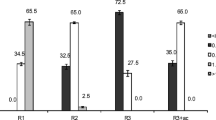Summary
Treating soluble wastewaters anaerobically in UASB-reactors, the development of sludge-granules can be expected, provided that there are optimal growing conditions. Two types of granules were obtained, both with high specific activities and excellent settling properties. Type 1 mainly consists of short fragments of multicellular filaments of a bacterium showing much resemblance with a recently isolated acetate-degrading methanogenic bacterium (Zehnder et al, 1980). Type 2 is mainly made up by long filaments of presumably the same bacterium. The development of anaerobic bulking sludge must be prevented.
Similar content being viewed by others
References
Lettinga, G. et al. (1980) Biotechn. Bioeng. 22, 699–734
Mulder, A.(1981)Internal rapport. Department fo Water Pollution Control, Agricultural University, Wageningen (in Dutch).
Pette, K.C. (1980) Purdue 35, 635–642
Versprille, A. (1978) de Ingenieur (in Dutch) 90, 762–765
Zeeuw, W. de (1980) Antonie van Leeuwenhoek 46, 110–112
Zeeuw, W. de and Lettinga, G. (1980) Purdue 35, 39–47
Zehnder, A.J.B. et al., (1980) Arch. Microbiol. 124, 1–11
Author information
Authors and Affiliations
Rights and permissions
About this article
Cite this article
Pol, L.H., Dolfing, J., de Zeeuw, W. et al. Cultivation of well adapted pelletized methanogenic sludge. Biotechnol Lett 4, 329–332 (1982). https://doi.org/10.1007/BF00132835
Issue Date:
DOI: https://doi.org/10.1007/BF00132835




